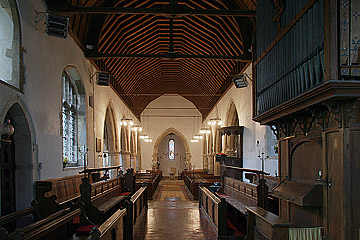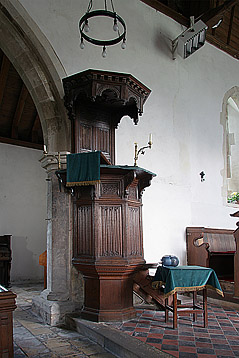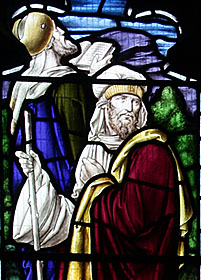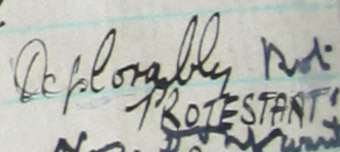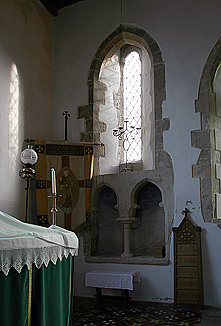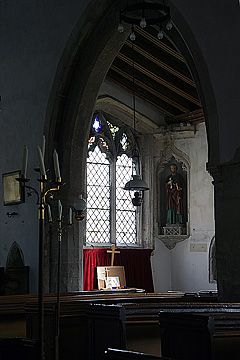St Peter sits on a rise overlooking the Cam. It's a small church now, and has suffered neglect over the years. William Cole in 1779 said that it was in a 'Deplorable, nasty, and shattered condition' and warned that 'unless the parish lay out an hundred or two pounds, will soon fall down'
It was restored in stages between 1825 and 1866, and much of the exterior bears the marks of this period. The tower is small and asymmetrical, with big buttresses (looking somewhat ad hoc) supporting the south-west corner. It has a very distinctive battlement with stepped crenellations rising like ziggurats in the corners, bestowed by one of the Victorian restorers. Other interesting details include the long striped roof that covers both nave and chancel; and the porch, which has two big lion gargoyles on the corners and a wrought-iron gate covered with twisting leaves and shoots.
Despite its present modest state, this was once a church of some pretensions. There was a minster here in the early 9th century, and although it was sacked by the Danes in the 870s, it was rebuilt and because quite important locally before falling under the influence of Ely. Nothing of the Saxon church itself remains, but there are a couple of Saxon coffin lids in the south aisle that have survived.
Stepping inside, the church feels long and thin and low, due to the loss of the rood screen and the lack of a chancel arch. The oldest part of the building is the south arcade, the piers of which date from a Norman rebuilding of the second Saxon minster. Later on in the early 13th century, Ely granted the church to St John's Hospital, Cambridge (which later became St John's College).
Either the Abbey or the Hospital rebuilt much of the church in Early English style, but only the arches of the south arcade survive from this, for there was another reconstruction in the 14th century that bestowed the north arcade and aisles. Perpendicular windows were later inserted into the aisles and chancel, some of which (in the north aisle, especially) were replaced by the Victorians.
Surprisingly, for a building with such a chequered history, St Peter retains quite a lot of medieval glass, albeit fragmentary and re-set. The best can be seen in the windows at the east end of the south aisle, in an old guild chapel.
These windows are also intriguing in style, containing elements of both Decorated and Perpendicular style. Between them, in the south-east corner, is a great niche with carving around the top and the shadow of a canopy above. It now contains a modern statue of St Peter. Below it, in the south wall, is a plainer niche for a piscina.
There are a few more remains of medieval glass in the north aisle, but for the most part the tracery was renewed by the Victorians, and filled with Victorian glass, including a pleasant image of the Good Samaritan.
At the entrance to the chancel is an impressive octagonal pulpit, dating from the turn of the 17th century, with dark linenfold panelling and a canopy over the top. Beside it is a big bracket marking where the rood beam must once have rested.
Beyond it, the chancel contains an interesting set of windows.The east window is Victorian, and seems to have been designed to echo those in the south aisle; there is another jumble of medieval glass reset into the tracery at the top. In the side walls, there is a combination of deeply cut lancets and bigger Perpendicular lights. One is filled with green glass that unfortunately casts an aquatic pallor over the altar, but most are clear.
I also noted the chancel roof, which has big tie beams linked to the ceiling by elegantly turned shafts. I don't know if it's very old, and rather suspect that it's not, but it's still a nice piece of craftsmanship. It's also difficult to tell the age of the piscina next to the high altar. It has two basins, and the arches over the top are of an almost Moorish design. In the church guide, Roy Tricker suggests that it may be 13th century, but I think the carving is too fresh and too strange for that. Maybe the basins are ancient, and the restorers put a new frame over them.
Funnily enough, my favourite thing of all was the visitors' book. It's an ancient one - almost as old as that at nearby Teversham - and was presented to the church on May 11th, 1935. It's still only somewhat over half-full, though this is presumably due to a big gap between 1961 and 1976 (perhaps it was lost for fifteen years). It contains several gems: early on, someone surnamed Crane from Fulbourn wrote 'Deplorably Protestant', to which someone else replied 'Rot!'. Later, Shirley Scott in November 1969 wrote 'Get some more ink please. Get some better lights please.', and someone further down the page demanded that a metal door (where?) be painted a different colour. I suppose it's a bit post-modern to concentrate on the remains of other visitors to the church, but a book as old as this gains a life of its own, breathing stale ancient air like a newly-released stratum of rock.
St Peter is kept locked, but a keyholder is listed.

